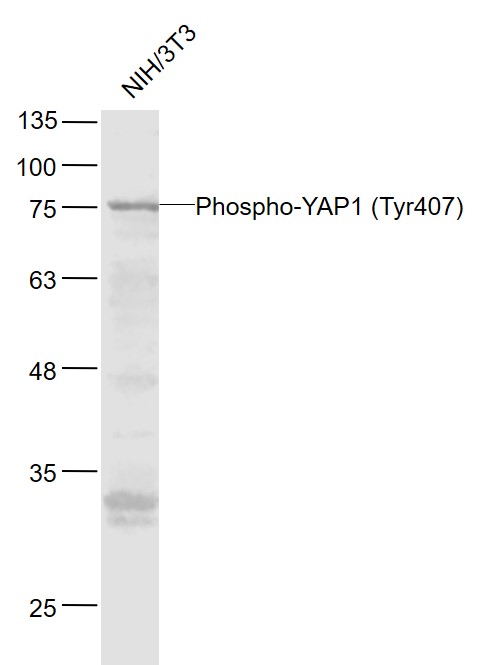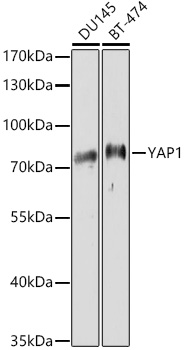YAP1 antibody
GTX129151
ApplicationsImmunoFluorescence, ImmunoPrecipitation, Western Blot, ImmunoCytoChemistry, ImmunoHistoChemistry, ImmunoHistoChemistry Frozen, ImmunoHistoChemistry Paraffin
Product group Antibodies
ReactivityDeer, Human, Mouse
TargetYAP1
Overview
- SupplierGeneTex
- Product NameYAP1 antibody
- Delivery Days Customer9
- Application Supplier NoteWB: 1:5000-1:20000. ICC/IF: 1:100-1:1000. IHC-P: 1:100-1:1000. IP: 1:100-1:500. *Optimal dilutions/concentrations should be determined by the researcher.Not tested in other applications.
- ApplicationsImmunoFluorescence, ImmunoPrecipitation, Western Blot, ImmunoCytoChemistry, ImmunoHistoChemistry, ImmunoHistoChemistry Frozen, ImmunoHistoChemistry Paraffin
- CertificationResearch Use Only
- ClonalityPolyclonal
- Concentration0.15 mg/ml
- ConjugateUnconjugated
- Gene ID10413
- Target nameYAP1
- Target descriptionYes1 associated transcriptional regulator
- Target synonymsCOB1, YAP, YAP-1, YAP2, YAP65, YKI, transcriptional coactivator YAP1, 65 kDa Yes-associated protein, Yes associated protein 1, protein yorkie homolog, yes-associated protein 2, yes-associated protein YAP65 homolog, yorkie homolog
- HostRabbit
- IsotypeIgG
- Protein IDP46937
- Protein NameTranscriptional coactivator YAP1
- Scientific DescriptionThis gene encodes the human ortholog of chicken YAP protein which binds to the SH3 domain of the Yes proto-oncogene product. This protein contains a WW domain that is found in various structural, regulatory and signaling molecules in yeast, nematode, and mammals, and may be involved in protein-protein interaction. [provided by RefSeq]
- ReactivityDeer, Human, Mouse
- Storage Instruction-20°C or -80°C,2°C to 8°C
- UNSPSC12352203
References
- Blokland KEC, Nizamoglu M, Habibie H, et al. Substrate stiffness engineered to replicate disease conditions influence senescence and fibrotic responses in primary lung fibroblasts. Front Pharmacol. 2022,13:989169. doi: 10.3389/fphar.2022.989169Read this paper
- Sun X, Gu X, Peng J, et al. PRDX2 Knockdown Inhibits Extracellular Matrix Synthesis of Chondrocytes by Inhibiting Wnt5a/YAP1/CTGF and Activating IL-6/JAK2/STAT3 Pathways in Deer Antler. Int J Mol Sci. 2022,23(9). doi: 10.3390/ijms23095232Read this paper
- Huang PY, Shih IA, Liao YC, et al. A novel HDAC11 inhibitor potentiates the tumoricidal effects of cordycepin against malignant peripheral nerve sheath tumor through the Hippo signaling pathway. Am J Cancer Res. 2022,12(2):873-892.Read this paper
- Sun X, Gu X, Li K, et al. Melatonin Promotes Antler Growth by Accelerating MT1-Mediated Mesenchymal Cell Differentiation and Inhibiting VEGF-Induced Degeneration of Chondrocytes. Int J Mol Sci. 2022,23(2). doi: 10.3390/ijms23020759Read this paper
- Tanaka H, Kondo K, Fujita K, et al. HMGB1 signaling phosphorylates Ku70 and impairs DNA damage repair in Alzheimer's disease pathology. Commun Biol. 2021,4(1):1175. doi: 10.1038/s42003-021-02671-4Read this paper
- Li CL, Huang CW, Ko CJ, et al. Curcumol Suppresses Triple-negative Breast Cancer Metastasis by Attenuating Anoikis Resistance via Inhibition of Skp2-mediated Transcriptional Addiction. Anticancer Res. 2020,40(10):5529-5538. doi: 10.21873/anticanres.14565Read this paper
- Zhu Q, Li J, Wu Q, et al. Linc-OIP5 in the breast cancer cells regulates angiogenesis of human umbilical vein endothelial cells through YAP1/Notch/NRP1 signaling circuit at a tumor microenvironment. Biol Res. 2020,53(1):5. doi: 10.1186/s40659-020-0273-0Read this paper
- Zhu Q, Li Y, Dong X, et al. Linc-OIP5 loss regulates migration and invasion in MDA-MB-231 breast cancer cells by inhibiting YAP1/JAG1 signaling. Oncol Lett. 2020,19(1):103-112. doi: 10.3892/ol.2019.11071Read this paper
- Pajtler KW, Wei Y, Okonechnikov K, et al. YAP1 subgroup supratentorial ependymoma requires TEAD and nuclear factor I-mediated transcriptional programmes for tumorigenesis. Nat Commun. 2019,10(1):3914. doi: 10.1038/s41467-019-11884-5Read this paper
- Chen MJ, Wang YC, Wu DW, et al. Association of nuclear localization of SHP2 and YAP1 with unfavorable prognosis in non-small cell lung cancer. Pathol Res Pract. 2019,215(4):801-806. doi: 10.1016/j.prp.2019.01.027Read this paper






